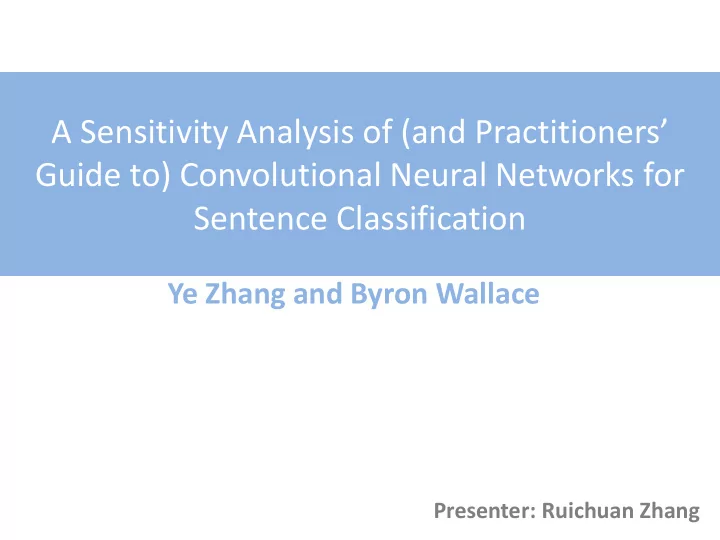

A Sensitivity Analysis of (and Practitioners’ Guide to) Convolutional Neural Networks for Sentence Classification Ye Zhang and Byron Wallace Presenter: Ruichuan Zhang
Content • Introduction • Background • Datasets and baseline models • Sensitivity analysis of hyperparameters – Input word vector – Filter region size – Number of feature maps – Activation function – Pooling strategy – Regularization • Conclusions
Introduction • Convolutional Neural Networks (CNNs) achieve good performance in sentence classification • Problem for practitioners: how to specify the CNN architecture and set the (many) hyperparameters? • Exploring is expensive – Slow training – Vast space of model architecture and hyperparameter settings • Need to conduct an empirical evaluation on the effect of varying hyperparameter on performance � use the results of this paper as a starting point for your own CNN model
Background: CNNs Input layer Output layer Hidden layer
Background: CNNs Sentence matrix 7 X 5 Activation function 2 feature maps Convolution for each size 3 region sizes: 2, 3, 4 2 filters for each size Totally 6 filters
Background: CNNs 6 vectors concatenated � single feature vector Regularization 1-max pooling & Softmax 2 feature maps 2 classes for each size
Datasets and Baseline Model • Nine sentence classification datasets [short to medium average sentence length (3-23)] – Examples • SST: Stanford Sentiment Treebank (average length: 18) • CR: customer review dataset (average length: 19) • Baseline CNN configuration (Kim, 2014): – Input word vector : Google word2vec – Filter region size : 3, 4, and 5 – Number of feature maps : 100 – Activation function : ReLU – Pooling : 1-max pooling – Regularization : dropout rate 0.5, l2 norm constraint 3
Datasets and Baseline Model • Baseline CNNs configuration: • 100 times 10-fold CV • Record mean and range of accuracy • Each sensitivity analysis: – Hold all other settings constant, vary the factor of interest • Each configuration – Replicate the experiment 10 times, each replication a 10- fold CV – Record average CV means and ranges of accuracy
Effect of Input Word Vectors • Three types of word vector – Word2vec : 100 billion words from Google News, 300- dimensional – GloVe : 840 billions of tokens from web data, 300- dimensional – Concatenated word2vec and GloVe: 600-dimensional • Performance depends on dataset • Not helpful to concatenant • One-hot vector : poorly [when training dataset is small to moderate]
Effect of Filter Region Size • Filter – Word embedding matrix A : s x d – Filter matrix W with region size h : h x d – Output sequence of length s - h +1: o , o i =W·A[ i:i+h- 1] E.g., filter with region size 3 Matrix convolution o 1
Effect of Filter Region Size • One region size – Each dataset has its own optimal filter size – A coarse search over 1 to 10 – Longer sentence (e.g., CR): larger filter size
Effect of Filter Region Size • Multiple region sizes – Combining close-to-optimal sizes: improve performance – Adding far-from-optimal sizes: decrease performance optimal sizes far-from-optimal sizes close-to-optimal sizes
Effect of Number of Feature Maps • Number of feature maps (for each filter region size) – 10, 50, 100, 200, 400, 600, 1000, 2000 • Optimums depend on dataset; fall in [100, 600] • Over 600: no much improvement and longer training time
Effect of Activation Function • Activation functions f : c i = f ( o i + b ) • Examples: Function Equation Softplus ReLu Tanh Sigmoid Identity • Tanh, Iden, ReLU perform better • No significant difference among the good ones
Effect of Pooling Strategy • Baseline strategy: 1-max pooling max pooling Maximum 𝑑 Feature sequence: c • Strategy 1: Max pooling over local region (size=3, 10, 20, 30): worse max pooling Local maximum max pooling Concat Feature sequence: c Local maximum … … • Strategy 2: K-max pooling (k=5, 10, 15, 20): worse • Strategy 3: Average pooling over local region (size=3, 10, 20, 30): (much) worse
Effect of Regularization • Dropout (before the output layer) Dropout rate – y = w · z + b , with a probability p that z i is dropped out z is concatenated maximum values 𝑑 – Dropout rate from 0.1 to 0.5: helps a little – Dropout before convolution: similar range and effect
Effect of Regularization • L2-norm constraint – Force 𝐱 2 = 𝑡 , whenever 𝐱 2 > 𝑡 – L2-norm constraint does not improve performance much – Does not harm too, so use one
Conclusions ( and Practitioners’ Guide) • Use word2vec or GloVe rather than one-hot vector • Line-search over single filter size from 1-10, and then combine multiple ‘good’ region sizes • Adjust the number of feature maps for each filter size from 100 to 600 • Use 1-max pooling • Test different activation functions (at least) ReLU and tanh • Use small dropout rate (0.0-0.5) and a (large) max norm constraint and try larger values when optimal number of feature maps is large (over 600) • Repeat CV to assess the performance of a model
Recommend
More recommend